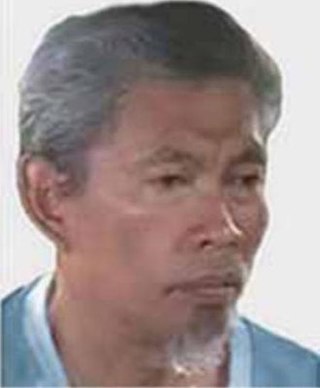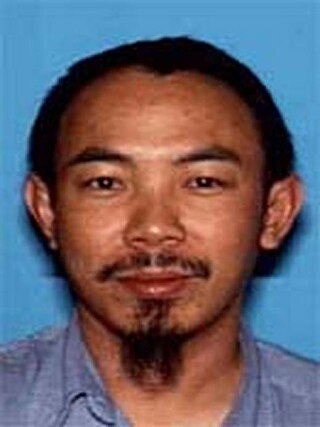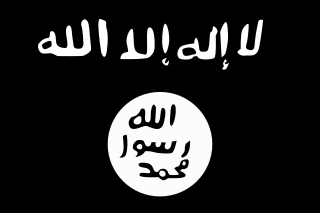
Abu Sayyaf, officially known by the Islamic State as the Islamic State – East Asia Province, is a Jihadist militant and pirate group that followed the Wahhabi doctrine of Sunni Islam. It is based in and around Jolo and Basilan islands in the southwestern part of the Philippines, where for more than five decades, Moro groups had been engaged in an insurgency seeking to make Moro Province independent. The group is considered violent and is responsible for the Philippines' worst terrorist attack, the bombing of MV Superferry 14 in 2004, which killed 116 people. The name of the group was derived from Arabic abu, and sayyaf. As of April 2023, the group was estimated to have about 20 members, down from 1,250 in 2000. They use mostly improvised explosive devices, mortars and automatic rifles.

Operation Enduring Freedom – Philippines (OEF-P) or Operation Freedom Eagle was part of Operation Enduring Freedom and the global War on Terror. The Operation targeted the various Jihadist terror groups operating in the country. By 2009, about 600 U.S. military personnel were advising and assisting the Armed Forces of the Philippines (AFP) in the Southern Philippines. In addition, by 2014, the CIA had sent its elite paramilitary officers from their Special Activities Division to hunt down and kill or capture key terrorist leaders. This group had the most success in combating and capturing Al-Qaeda leaders and the leaders of associated groups like Abu Sayyaf.

The Moro conflict was an insurgency in the Mindanao region of the Philippines which involved multiple armed groups. A decades-long peace process has resulted in various peace deals have been signed between the Philippine government and two major armed groups, the Moro National Liberation Front (MNLF) and the Moro Islamic Liberation Front (MILF), but other smaller armed groups continue to exist. In 2017, the peace council settled around 138 clan conflicts.

Isnilon Totoni Hapilon, also known by the nom de guerreAbu Abdullah al-Filipini, was a Filipino Islamist militant affiliated with ISIS. He was formerly leader of Abu Sayyaf Group, before its battalions pledged their allegiance to Abu Bakr al-Baghdadi. An April 2016 issue of ISIL's weekly newsletter Al Naba said that Hapilon had been appointed as "emir of all Islamic State forces in the Philippines".

Dulmatin was a senior figure in the militant Islamic group Jemaah Islamiyah (JI) based in Indonesia, and one of the most wanted terrorists in Southeast Asia. He was also known as Amar Usmanan, Joko Pitoyo, Joko Pitono, Abdul Matin, Pitono, Muktarmar, Djoko, and Noval. He also had the nickname "Genius". Dulmatin was an ethnic Javanese with a height of 172 cm, weighing 70 kg, with a brown complexion.

Radullan Sahiron is a Filipino Islamic militant who is the leader of Abu Sayyaf. He is said to have taken command of the organization following the death of Khadaffy Janjalani in September 2006.
The civil conflict in the Philippines as of February 2019, consists of an insurgency pitting government forces against Maoist rebels, that began in 1969 during the rule of Ferdinand Marcos.

Zulkifli Abdhir was a Malaysian who was one of the FBI Most Wanted Terrorists. The American Federal Bureau of Investigation (FBI) agency offered a US$5 million reward for information leading to his capture. He was the maker of bombs delivered for usage to several terrorist groups. He was often referred to by the nom de guerreMarwan. He was suspected of leading the Kumpulan Mujahidin Malaysia (KMM), being part of the central command of the Jemaah Islamiyah (JI), and of involvement in the 2002 Bali bombings. He was suspected of hiding in Mindanao under the protection of the Bangsamoro Islamic Freedom Fighters.

The Bangsamoro Islamic Freedom Fighters (BIFF), also known as the Bangsamoro Islamic Freedom Movement, is an Islamist jihadist militant organization based in Mindanao, in the southern Philippines. It is a smaller player in the overall Moro insurgency and is mostly active in Maguindanao and other places in central Mindanao. It is a breakaway group from the Moro Islamic Liberation Front founded by Ameril Umbra Kato. Following Kato's death, the group split into three factions, one of which has aligned with the Islamic State, while the other two are less radical.

The Islamic State (IS) had its core in Iraq and Syria from 2013 to 2017 and 2019 respectively, where the proto-state controlled significant swathes of urban, rural, and desert territory, mainly in the Mesopotamian region. Today the group controls scattered pockets of land in the area, as well as territory or insurgent cells in other areas, notably Afghanistan, West Africa, the Sahara, Somalia, Mozambique, and the Democratic Republic of the Congo. As of 2023, large swathes of Mali have fallen under IS control.
The following is a list of attacks which have been carried out by Abu Sayyaf, a militant group based in and around Jolo and Basilan islands in the southwestern part of the Philippines, where for more than four decades, Moro groups have been engaged in an insurgency for an independent province in the country.

Dawlah Islamiya, also called Islamic State of Lanao and formerly named as the Maute Group, is a radical Islamist group composed of former Moro Islamic Liberation Front guerrillas and foreign fighters. Based in Lanao del Sur, it was founded by brothers Abdullah and Omar Maute. The organization, which also conducted a protection racket operation in the municipality of Butig, clashes on several occasions with the Armed Forces of the Philippines, the most significant of which began in May 2017 and culminated in the siege of Marawi.

Ansar Khalifa Philippines (AKP), also referred to as Ansar al-Khilafah in the Philippines and Ansarul Khilafah Philippines was a Philippine-based militant group that emerged in August 2014 when it released a video pledging allegiance to ISIS. The Armed Forces of the Philippines characterized the group as "bandits" engaging in cattle rustling and extortion activities. Malaysia listed the group as terrorist organization in 2019.

The siege of Marawi, also known as the Marawi crisis and the Battle of Marawi, was a five-month-long armed conflict in Marawi, Philippines, that started on May 23, 2017, between Philippine government security forces against militants affiliated with the Islamic State (IS), including the Maute and Abu Sayyaf Salafi jihadist groups. The battle also became the longest urban battle in the modern history of the Philippines.
The Philippines is one of the state opponents of the militant group, Islamic State of Iraq and the Levant (ISIL), more commonly referred to by the local media as the Islamic State of Iraq and Syria (ISIS).
This is a chronology of the Moro conflict, an ongoing armed conflict in the southern Philippines between jihadist groups such as the Abu Sayyaf Group, the Maute Group, Jemaah Islamiyah, and Islamic State affiliates, mainstream separatist groups such as the Moro Islamic Liberation Front (MILF), the Moro National Liberation Front (MNLF) and the Bangsamoro Islamic Freedom Fighters (BIFF), and the Philippine Government since 1971. Much of the fighting has been concentrated on the island of Mindanao and the Sulu archipelago, with spillover incidents and attacks occurring in the Philippine capital Manila and neighboring countries such as Malaysia.
On July 31, 2018, a bomb exploded in the town of Lamitan in Basilan, Philippines.
Hatib Hajan Sawadjaan was a Filipino militant affiliated with the Abu Sayyaf. He was the leader of the group which has associated itself with the Islamic State of Iraq and the Levant (ISIL) since 2014. On July 6, 2020, Hajan Sawadjaan was severely wounded during an encounter with the government troops in Barangay Bakong, Patikul, Sulu and died from his injuries a few days later. After the encounter with the government troops, he was found and buried by the group of his cousin Mundi Sawadjaan, an Abu Sayyaf sub-leader.
The 2020 Jolo bombings occurred on August 24, 2020, when insurgents alleged to be jihadists from the Abu Sayyaf group detonated two bombs in Jolo, Sulu, Philippines, killing 14 people and wounding 75 others. The first occurred as Philippine Army personnel were assisting in carrying out COVID-19 humanitarian efforts. The second, a suicide bombing, was carried out near the Our Lady of Mount Carmel Cathedral.









